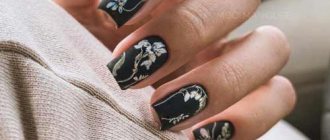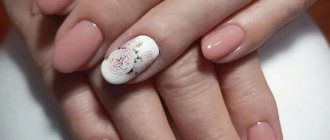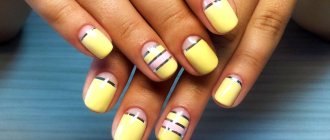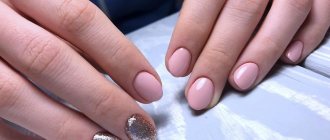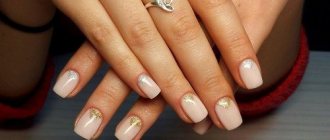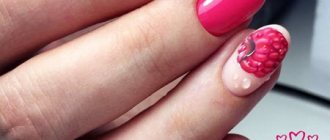Until recently, in the arsenal of manicurists there were varnishes and gel polishes that included crushed foil and glitter, but did not give a 100% stylization of crushed jewelry or molten precious metals. With the advent of “mica” sparkling gel polishes, all the dreams of beauties about an irresistible, stunningly beautiful manicure, sometimes surpassing in entertainment even such popular decorative elements as Pixie Swarovski crystal chips, came true. What is the secret of the charm and success of new gel polishes? How to correctly create a design with their participation and what images with liquid mica are now at the peak of popularity? We will tell you about all this today.
Mica is the secret of sparkling manicure
Manicure mica is small thin plates, similar to shavings or pieces of foil, has a pearlescent sheen, and shimmers when exposed to light, which gives decorated nails additional volume and depth of color.
This material preserves your manicure longer, as it copes well with loads and is almost not susceptible to chipping.
This is a light, almost weightless decoration, so it does not require any extensions.
This design can be done on natural (short or long) nails of various shapes (from oval to sharp).
However, it is usually used specifically on extended nails, since the design must be “sealed”, i.e. cover with an additional layer of varnish. Otherwise, the plate will be ribbed, rough, and pieces of decoration will quickly fly off.
File manicure courses
For masters who have not yet mastered the technique, but want to expand their capabilities and practice their skills, we suggest that you familiarize yourself with the nail file manicure courses.
Mastering the technique will bring masters:
- increasing the level of professionalism;
- the expansion of the customer base;
- saving time.
In addition, the cost of a file manicure procedure is lower than, say, an edged manicure. To work, you only need disposable files or replaceable files for the block.
Luxio
The brand of manicure products provides training in Moscow and St. Petersburg. The program has two types of courses:
- for craftsmen working in cutting equipment;
- for craftsmen working using the hardware method.
Cost – 10,000 rubles.
Duration of training is 1 day. Upon completion of the course, a certificate is issued.
Nail Experts
A two-day course with theoretical and practical parts for Moscow residents. The school provides models as well as tools for practicing techniques.
The cost of training is 17,000 rubles.
At the end of the second day, each participant who has successfully completed the course receives an international certificate.
Nail Sunny
A one-day course from a chain of manicure salons in Moscow. All students are provided with material and tools, as well as models for practicing techniques.
Cost – 7,500 rubles.
Types of manicure mica
There are two varieties: regular and liquid.
Space manicure design with mica
The usual one is a powder material of dry glitter, dense and hard.
Some of them are too large, so before manicure you need to inspect the material and cut with scissors those plates that are too large.
You can decorate any area of the nail. To lay out glitter you need:
- base (varnish);
- drying-fixer;
- stick or brush;
- container with water.
You need to apply the plates onto the newly applied layer of varnish using a stick. Use a brush to cover the entire nail.
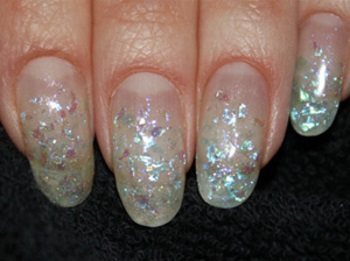
Original discreet manicure with mica
Liquid mica (other names: liquid foil, wet glitter) is a varnish with glitter; it lays on the surface more evenly, so you don’t have to use a stick.
Apply the base, followed by one or two coats of wet gloss. Pieces of mica may “break through” the coating, so again a sealer will be needed. This type of material is used to decorate natural nails.
Mica for nail art, what is it?
In the precise meaning, mica is a natural material. It is a layered mineral with a sparkling, translucent, pearlescent structure. This mineral looks very beautiful. Later, manufacturers learned to imitate natural mica, creating artificial thin foil plates, shining and multi-colored, which began to be used as decoration in various areas of the beauty industry. Manicures are made with mica, and it is also used in some types of needlework. But it was in nail art that this material “took root” best.
Mica for nails can be liquid and dry (loose). The latter is sold packaged in various jars or simply bags. Liquid most often takes the form of varnish and is applied to the nails with a brush. You can purchase this incredibly beautiful material for nail design in any nail art department. A huge number of colors, shades and structures will allow you to choose mica to suit every taste and any manicure fantasy.
What loose mica looks like, photo:
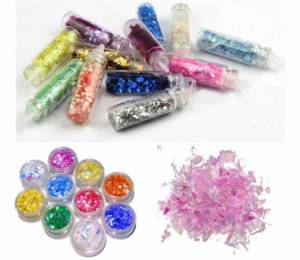
loose mica
Liquid mica, photo:

Liquid mica
Decorating nails with mica at home step by step
The technique of using liquid and regular material is different, but the initial stage is the same - you need to treat your nails:
- trimming;
- grinding;
- applying the base layer.
Nail designs using mica should be done on gel polish, since the glitter firmly “sticks” to the sticky layer, which guarantees a longer lifespan of the manicure.
Manicure with regular mica
- Colored gel polish is applied to the base and then dried in a lamp for 2 minutes.
- Using an orange stick, the desired pattern is laid out with glitter.
You can cover the entire nail with a thick layer of mica plates - then it will be bulky, heavy, and to create an unobtrusive image, the plates need to be distributed at a distance from each other.
- Cover the nail with cling film, press it down, carefully straightening the mica with your finger.
- Dry in a lamp for about 30 seconds.
- Remove the film and apply the final coat of varnish. Dry for another 2 minutes.
Next, you need to carefully examine the resulting design: if there are uneven, protruding pieces, carefully file them, but do not try to straighten them with your finger. Are you sure the surface is smooth? Cover it with another protective layer.
For more information about what ordinary mica is, what it is like and how it is applied, watch the video.
Manicure with liquid mica
Liquid glitter is successfully used on short nails. In this case, cling film is not needed - you need to stock up on a brush.
- Apply gel polish to the base layer and dry it in a lamp.
- Using a brush, we “catch” the glitter and cover the desired part of the plate with it.
- Use a brush to level the surface. Dry for about 20 seconds.
- Apply a final protective layer and dry again.
It is not necessary to apply a second finishing layer, because... The structure of liquid foil is softer. If you find any irregularities, sand them with buff.
You will learn more about liquid mica from the video:
Advantages and disadvantages of design with liquid mica gel polishes
The main condition is that the coating must not only be safe for the health of the nails, but also have an optimal texture thickness and density of decorative particles. Previously, craftsmen “fine-tuned” varnishes and gel polishes by adding glitter, rubbing or tiny mica to them in order to obtain the desired intensity of shine and density (hiding power). With the advent of specialized coatings, the work of a manicurist has become significantly simplified and the boundaries of creative experiments have expanded. At the same time, gel polishes of this type have their own nuances that you need to know about when choosing them for your manicurist. Let's look at the main pros and cons of “sparkling” nails.
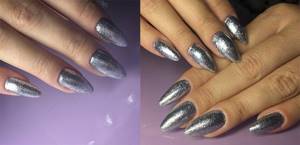
The advantages of liquid mica coatings include the following:
- There is no need to very carefully level your nails with special bases for polish and gel polish before applying the iridescent texture. Due to the shine of the smallest particles of mica, the nail becomes like a cut stone, hiding possible aesthetic defects.
- Reducing time to create a design. Depending on the shade you choose, the artist can create a design by applying just one layer of gel polish. The nails will be completely hidden under a layer of decorative coating, and the final image will be lighter in weight. Which is especially important for nails that tend to break under gel polish due to their inherent fragility.
- Ease of working with the material itself. Gel polishes of this type are quite thick in themselves and do not “run away” to the cuticle and side ridges. The density of their texture will allow both the beginning artist and the novice to create images using the popular “under the cuticle” technique. And you won’t need to sophisticatedly correct application flaws, as often happens with more liquid gel polishes.
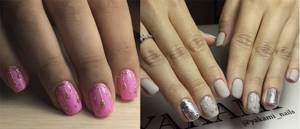
- Comfortable application and polymerization, wearing the design and removing the coating. By choosing this type of decor for fingers from any of the manufacturers, you can be sure of problem-free polymerization (the coating in the lamp does not burn your nails too much, does not form bubbles and does not flow to the free edge). When applied, “liquid mica” does not require any sophisticated preparation and is distributed over the nail as simply as regular shellac - in a thin layer. A nice bonus is that these gel polishes are perfectly self-leveling and do not streak. There is no need to worry about removing manicure, since “liquid mica” is removed as quickly and easily as regular gel polishes with a “cream” texture (by soaking in foil with preparations for removing gel textures, or with a Fraser).
- The ability to create a luxurious manicure with a minimum of effort on nails of any length and shape. “Mica” gel polishes look wonderful on both short natural ones and extensions (gel or acrylic). When worn, they do not fade or chip, the color component does not fade, and the dense shimmer does not become cloudy even when in contact with household chemicals.
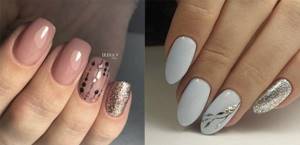
As for the not so probable disadvantages, these can be considered:
- The need to apply the coating with a separate brush (relevant for Irisk Glossy Platinum gel polishes; the shellac jar does not have a brush) for a more uniform, thin application.
- Attention to storage and distribution in the design of these gel polishes. When using them in your work (especially decor in jars rather than bottles), you need to carefully ensure that the gel polish does not accidentally come under the influence of UV rays from your lamp. And when scooping from a jar with a brush, try to do it carefully so that air bubbles do not settle in the thickness of the material.
- Moderation in decor. Liquid mica gel polishes are so spectacular in themselves that the design with them should not be overloaded with additional sparkling decor. It is better to make the most of the beauty of the gel polish itself. For example, creating such popular images as sparkling drops.
- Limited color range. Unlike their equally popular counterparts (cat's eye gel polishes, classic thermal shellacs, glitter coatings or cream texture gel polishes), liquid mica coatings still have significantly fewer color options. However, with the advent of new trendy colors (following the annual reports of the Pantone Color Institute), the range of shades of “liquid mica” is gradually expanding.
- Careful wearing of the design. As manicurists like to emphasize, even the most durable gel polish is not hardened steel. The shimmering design must be handled with particular care. Any chips or cracks will be very noticeable and will spoil the beauty of your nails.

How to tame “liquid mica” gel polishes and create enchantingly beautiful nails with their help? Let's look at the technology of step-by-step image creation using the example of Irisk Glossy Platinum and Grattol Vegas coatings.
Designer delights
For greater effect, cover not the entire nail plate with mica, but part of it:
- Apply the base, dry, remove the sticky layer.
- Apply designs with gel (flower petals, stripes, geometric shapes), dry. Do not remove the sticky layer.
- Apply glitter to the desired elements, blend with a brush - they will remain only on a sticky base.
- Brush off any remaining residue.
- Apply a final coat.
If desired, you can decorate the base with additional lines and monograms. After secondary decoration, you need to apply another layer of topcoat.
This video tutorial will show you how to easily and quickly make a beautiful glass manicure at home.
Hardware medical manicure
As in a standard hardware manicure, the procedure is based on the use of a special device with many attachments and cutters. They differ in the degree of hardness and abrasiveness. They treat fingers, periungual ridges, cuticles, and nail plates. In this case, the nozzle changes each time depending on the condition of the hands.
Hardware manicure is performed only on dry hands. Steaming in a bath should not be done before it, as this increases the risk of cutting yourself. It’s impossible to choose the right cutter without experience in this matter, so it’s better to turn to a professional.

Bright manicure ideas with mica
- The “smiling” design (French) looks elegant : The design is limited only by the imagination of the master: the sparkles can be painted not only white, but in any shade of the color palette. In addition, you can combine selected colors, resulting in a unique project.
- A red manicure with mica will look solemn and beautiful on your nails.
- A manicure “a la broken glass” is suitable for creative people who want to emphasize their individuality.
- A great option for a manicure using mica would be a starry sky design on your nails.
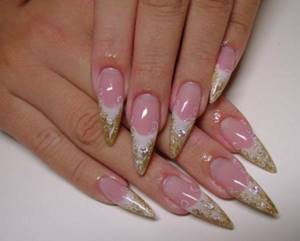
French manicure with gold mica on sharp nails

Red manicure with mica design
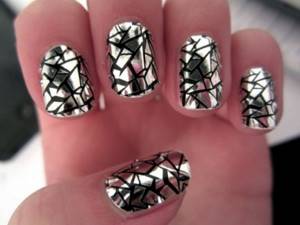
Glass manicure with mica
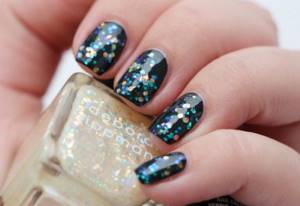
Starry sky on nails
Technique for creating a manicure with micromica gel polishes
In order to decorate your nails with a bright, precious outfit, you need to perform preliminary basic preparation. It consists of the following steps:
- removing the cuticle (using a remover or fraser, or performing a classic trim manicure with tweezers/nail scissors);
- removing gloss from the surface of natural nails using a polishing buff (or a file with an abrasiveness of 240 grit);
- applying a degreaser and air-drying the nails for 30 seconds, and then applying a primer and bonder to ensure reliable adhesion of the gel polish base to the nail;
- covering the nails with a thin layer of base and polymerizing it in a lamp (in a UV device - 2 minutes, and in an LED lamp - 60 seconds);
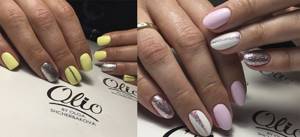
- applying the selected shade of gel polish in 1-2 layers. For Glossy Platinum coatings, you will need a separate brush to distribute the decorative layer more thinly and evenly. Whereas the Vegas collection from Grattol can be easily and beautifully applied with a native brush. When creating an image, remember: Grattol Vegas gel polishes are denser and thicker than Irisk Glossy. "Vegas" is more covering and as dense as possible, while "Glossy" will require 1-2 layers for a perfect manicure. To polymerize coatings of this type, you will need UV lamps with a power of at least 36 Watts, or a hybrid (combined LED lamp) with a power of at least 12 Watts. An important point: before applying, thoroughly stir the gel polish, but do it very carefully so as not to accidentally saturate the coating with unnecessary air bubbles.
- Each layer of “liquid mica” must be dried in a UV lamp for 1-2 minutes (for an LED device, the drying time will be 20-30 seconds) and the stickiness removed using a special preparation and a lint-free cloth.
- To complete the manicure, cover your nails with a top coat (glossy or matte) and remove the dispersion layer (if you do not plan to complement the manicure with other decorative elements).
- The finishing touch is to apply nourishing oil to the cuticle and lightly massage the skin adjacent to the nails. All! The precious nail-look is ready and will delight its owner for 3-4 weeks.
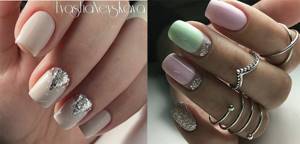
What image should you choose to reveal all the beauty of “liquid mica” gel polishes? Practicing manicurists highlight the 5 most spectacular options. Let's get to know them and choose the look that suits you!
Useful tips
- Dry mica is a capricious material. Before you start manicure, carefully inspect the plates. If you find large particles, cut them with scissors. You can do the same with small sparkles if you want a “beaded” design.
- Don't be afraid to add extra layers of topcoat to your extended nails; the mica will come out from under one final coat. Several coatings are the key to a long-lasting manicure. If you add another layer of mica after each topcoat, the design will become more voluminous and create a beautiful overlay effect.
- Does the color fade when polishing your nail? Do not worry! Polishing is needed to even out the layer. The color and brightness will return when you coat the plate with topcoat.
- When using a brush or spatula, remember to wet it with water from time to time to remove magnetization.
Manicure mica adds extra volume to your nails and deepens the color. The design is therefore in 3D format.
Liquid foil is suitable for natural nails because it applies more smoothly and does not require strong fixation.
Loose material is an ideal option for extended nails. With its help, you can bring any idea to life: from a simple French jacket to fancy monograms.
More interesting articles:
How to use dry mica
Mica nail polish can be used in many different ways. You can use it to lay out the entire nail, the French area, or use it to create a specific pattern on the nail. In order to apply crumbly mica to your nails, you will need the following:
- Base varnish: it can be varnish of any shade or simply transparent;
- Drying-fixer (in extreme cases, mica can be coated with ordinary transparent varnish);
- Orange stick (this can also be a dots or a simple toothpick);
- Small container with water;
- Mica of the selected shade.
How to apply:
- Before starting the design, be sure to do at least a light manicure, align all your nails to the same length so that your hands look well-groomed;
- Apply one coat of base varnish first and let it dry slightly. Then apply the second layer, but without waiting for it to dry, start applying mica to your nails. This is done like this: dip an orange stick (toothpick or dots) in water to remove the electrification, then pick up a little mica on the tip and transfer it to the nail, laying it out in the desired order. If you want to cover the entire nail plate with mica, you can use a brush, also dipping it first in water, then in mica.
- Finish the manicure with a dryer or any other top coat.
Nail decor with casting
If you follow fashion trends, you know that liquid stones are the most popular casting. This idea of decorating a manicure is very complicated, since in addition to special materials, you need the skill to use them, so you need to go to a beauty salon. However, even in this case, there is no 100% certainty that it will be done well there, because not everyone has mastered this technology yet. Of course, fake jewelry is used here, but if the manicure is done by a good master, the difference will be insignificant, and the impression of others will confirm this. No, the stone will not be so massive that it is difficult to even raise your hand. This is only a visual similarity. The special material used to create this manicure is polymer. It is designed to imitate real precious stones.
If you add a little imagination and desire to willpower and patience, then your own masterpieces on your nails will look no worse than those in the salon. And the design of nail plates with mica will complement any image, adding a touch of unusualness to it. Good luck and inspiration!
Mica honeycomb design
A manicure with bright mica honeycombs is extremely beautiful and original. This design can be easily achieved by using shiny mica in a regular shape. For example, hexagonal mica, the same color as the main varnish, is placed in the correct order on the entire surface of the nail plate of one, several or all fingers. It is important to remember that non-plastic, shiny mica is a very rich element in nail decoration, so you need to use this spectacular and fashionable nail design sparingly and tastefully.
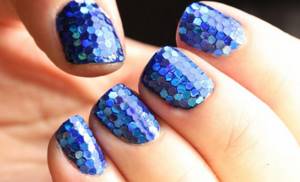
How to use broken glass foil?
Foil
“
Broken glass
” is cut into pieces with nail scissors of the required size and laid out along the French line (hole) or simply randomly distributed on a sticky layer or on a base (a base is more convenient), then dried in a lamp, and covered with a top coat, also dried in a lamp.
Interesting materials:
How can I find out what port I have? How do I know what type of facial skin I have? How to find out what power supply you have on your PC? How do you find out what video card driver you have? How to find out PC components? How to find out the components of your PC? How to find out PC components? How to find out the power of a computer? How to find out what allergies are tested for? How to find out the volume of a suitcase?
Required tools and materials
As previously stated, this type of manicure does not require any special means or tools; a minimum set will be enough. Let's take a closer look at what tools you may need and their purpose.
- Scissors or nail clippers are used to easily trim the excess length of the free edge of the nail plate. Some people use these items to remove cuticles, but this should not be done, as you can easily get injured.
- File for processing the free edge of the nail.
- It is necessary to have special scissors for removing cuticles, as with them the procedure will be safer and painless.
- In some cases, you may need so-called cutters - pliers designed to remove the skin of the nails.
- A container for water in which you can make a bath for your nails and soften the cuticles.
- You will need a couple of dry, clean towels or thick paper napkins.
- To prepare a bath, you need to acquire special salts and oils, or you can use ordinary hand soap.
- Some people use orange sticks or a special spatula. Typically, such tools are double-sided - on one end there is a pusher for pushing back the cuticle, on the other there is a sharp scraper used to remove it.
- If you wish, you can use a cuticle remover, but if you have the other listed tools, this is not at all necessary.
- To treat the surface of the nail, you will need a soft file - a buff, which will help smooth out all the roughness and give the nail plate a glossy shine.
- For decoration, you need to get nail polish, and for a more durable coating, it is better to use shellac.
- At the end of the procedure, you must use cuticle oil or hand cream containing beneficial substances and vitamins.


